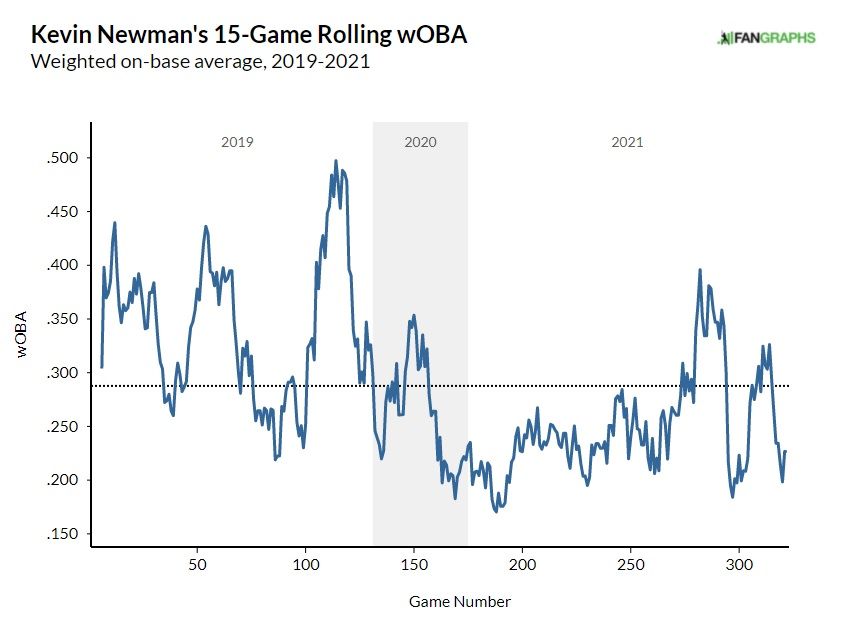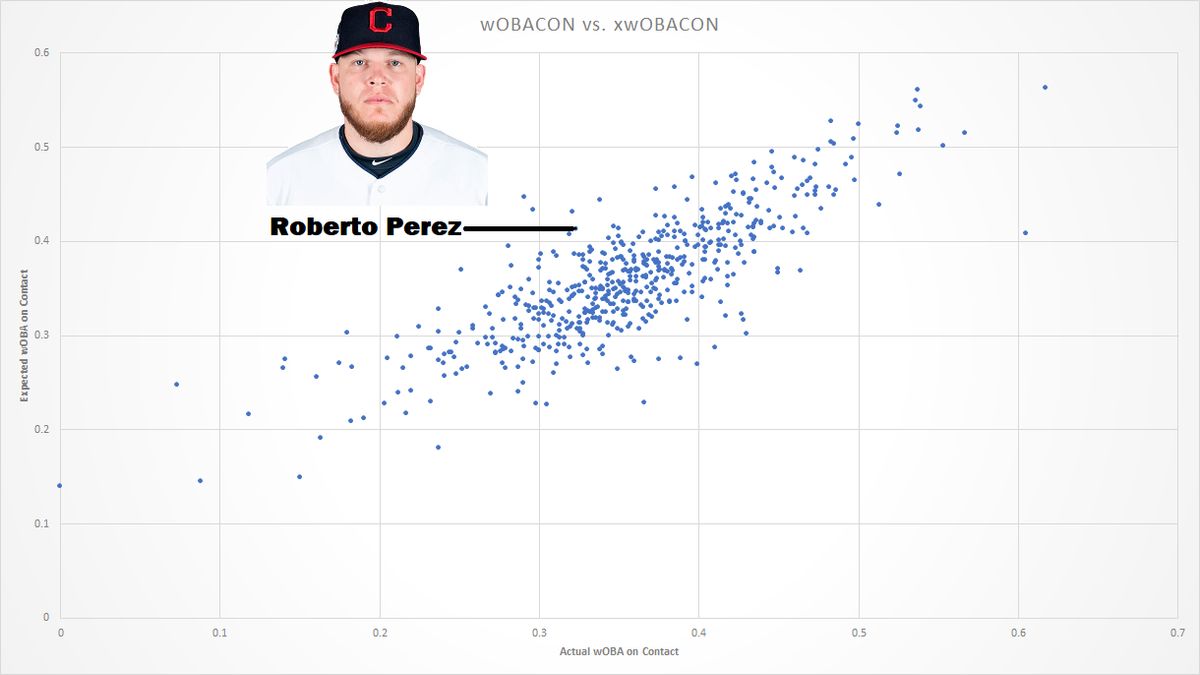Last week, the Pirates signed a pair of players to one-year deals. Given their roster construction, one was very predictable, inking Roberto Pérez to a one-year pact for $5 million. The other was a bit perplexing, avoiding arbitration with Kevin Newman for $1.95 million.
In Pérez’s case, the Pirates did not have any catchers on their 40-man roster at the time after trading Jacob Stallings to the Marlins, and he was arguably the best catcher available in a weak free agent class. He was bit by the injury bug in 2021, but had won Gold Gloves the previous two seasons.
“There’s pop in the bat,” Ben Cherington said before the lockout. “2020 was down and then he was banged up this year. We're excited about getting him healthy and seeing what he can do offensively. We feel good about him coming in and helping us behind the dish.”
For Newman, he signed just ahead of the non-tender deadline, and it looked like a case where he would need to ink a deal or be let go, despite the fact that he had emerged as one of the National League’s best defensive shortstops and was nominated for a Gold Glove. The latter seemed plausible, if not probable, because Cole Tucker and Oneil Cruz are already on the 40 man roster and could take major league shortstop duties either now or in the early part of next season. Instead, that position will be up for grabs in a spring training competition.
Assuming both play enough innings to qualify, the Pirates could potentially be in the mix for Gold Gloves again. They could both also finish with a sub-.600 OPS again.
It’s been a rough two years for these hitters. Newman batted .308 with an .800 OPS as a rookie in 2019. Pérez hit 24 home runs with a .774 OPS that year. They have some level of offensive upside. But they have both been just terrible at the bat since then.
Newman had a .574 OPS over 554 trips to the plate in 2021, the worst of any hitter who qualified for the batting title. The next lowest OPS among a qualified National League hitter was Tommy Edman at .695, a whole 121 points higher.
The 2020 season wasn’t any kinder to Newman, and looking at his 15-game stretches the last three years, most of his output the last two years has matched his worst offensive lulls from his rookie season:

Meanwhile, Pérez slashed just .149/.245/.319 over 161 plate appearances, but despite the injuries and horrid actual results, there were some encouraging signs for him offensively in 2021. Perhaps not to the point where he can be a middle of the order bat, but enough to justify starting him for his glove.
Pérez has always done some things well, like posting a consistent 10% walk rate year in and year out, a byproduct of being a good framer and knowing the strike zone. He walked 10.6% of the time in 2021, right in line with his career norm. He also showed that aforementioned pop, going deep seven times despite logging only 21 hits.
The contact he made was actually quite good. Now this needs to be looked at through two important lenses, that it’s a small sample size and he struck out in one-third of his plate appearances, thereby shrinking the sample ever further. But when he actually got the bat to the ball, it was usually tagged. His 91 mph average exit velocity was a career best, and his .413 expected wOBA on contact (xwOBACON) put him in the top 20% of hitters with at least 50 batted ball events (108th of 556). Some of the other hitters who exactly matched his xwOBACON are Matt Olsen, Trea Turner, Yoan Moncada and Willy Adames.
Pérez didn’t get the same results with his contact, though. Even with seven home runs boosting his total, his .323 actual wOBA on contact was quite mediocre. I charted out how his actual vs. expected results compared to the rest of the league, and he was a bit of an outlier:

DATA FROM BASEBALL SAVANT
Ideally, you’d want to be in that top right corner. It means you struck the ball well and you were rewarded for it with hits. There aren’t too many hitters as high as Pérez on the y-axis with as mediocre of actual results.
Cherington said he made the trade because he saw an opportunity to add young players to the system while maintaining the same strength behind the plate. Pérez is definitely riskier than Stallings -- hence why the Marlins were willing to give up three players for Stallings rather than sign Pérez to solve their catching need -- but he has a good reputation with the glove and pitcher management, and if you believe in his limited sample from last year, he could be an ok three true outcome hitter and provide the lineup with some sorely needed right-handed power.
With Newman, though, the case is not nearly as clear-cut. In fact, in those areas that foster some hope for Pérez, Newman struggled. He walked in less than 5% of his plate appearances. When he made contact, he had a wOBACON of .247 and an xWOBACON of .277, both of which rank in the bottom 10% of baseball, alongside more than a handful of pitchers. His average exit velocity (85.3 mph), hard hit rate (26%) and barrel rate (1.6%) all ranked in the bottom 3% of the league.
It’s fair to point out that Newman’s .800 OPS season in 2019 was based on him outperforming his peripherals, but those peripherals gradually improved as the season went on. It’s one thing to say he just got lucky. It’s another to start out a little lucky, but gradually improve in those areas until it evens out. Fake it until you make it. Perhaps there’s a chance he can beat those peripherals again to give his slash line a boost.
But when it comes to Newman, his greatest strength as a hitter, being able to get the bat to the ball and not whiff, might also be his greatest detriment. The best evidence for that comes not only in the balls he puts in play, but the ones he fouls off. I took a sample of 220 hitters who hit at least 250 foul balls last season, and Newman his a foul ball in 31.8% of his swings. That was the second lowest-rate in baseball, behind Vladimir Guerrero Jr. There were a lot of all-or-nothing, three true outcome hitters on that list. Newman isn’t that type of guy.
So Newman makes contact better than just about any hitter in baseball, but he doesn’t strike the ball well and he’s far more likely to put a ball in play than foul it off. Not only is weak contact rarely good, but this is a recipe for shorter at-bats, depriving Newman of some much-needed walks. You can be a singles hitter in this power-driven league, but you can’t be a singles hitter with a .265 on-base percentage.
Every team can get away with having a light hitter who is an excellent fielder somewhere in the lineup, and the two most premium defensive positions are catcher and shortstop. The Pirates can’t afford to have two guys with a sub-.600 OPS bat back-to-back at the end of the lineup though. Pérez might not be too far removed from a good offensive season. Newman is going to need more work, but the Pirates wouldn’t have offered him a contract if they thought last year was his offensive potential.
“One of the things we admire about Kevin is that when he has a challenge in front of him and he’s given a challenge, he works his tail off and gets after it,” Cherington said. “He’s almost narrowly focused on accomplishing a task. He was challenged last winter on his defense and sure enough he improved it. I know from talking to him a lot during the season and after the season he feels challenged about his offense and he’s committed to finding a way to improve, so we trust him to do that work. We’ll see how that plays out.”

